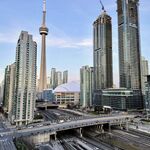A magnitude increase from the current $1.40 a litre would be $14/litre. Seems pretty unlikely that would happen, but when gas hit 20 ¢/L, who thought we'd see it at $1.40?
That's true, but I mean, look at the result. A seven-fold increase in the cost, and yet, more cars than ever on the road. I remember gas hitting a dollar a gallon around the time I was ten (there was a gas station outside my bedroom window). We were in the process of metrification then (yeah, no kidding, huh?), with both prices quoted, so that would have been around the time gas was roughly a quarter a litre. By the time I got my license, it was in the neighbourhood of the mid-40s a litre. It hit 80¢ a litre around the time I got my previous car, which was early in 2005. Swore I wouldn't fill the tank till it got back to something sensible... still tend to do it in $20 increments... smaller all the time.

The point I'm getting at here is that while prices have increased, so have wages. I would imagine gas takes a bigger percentage chunk of that than it used to, but probably not all that much. I'm amazed to still see SUVs and vans on the roads, but apparently some people are just fine with paying that premium for utility. I think there'd have to be a real sudden, hard shock--not so much in price, but actual AVAILABILITY of gasoline--before people would really start to abandon their cars. And let's face it, we don't seem anywhere near that as far as I can tell and yet we're already seeing hybrid vehicles and real stabs at electric cars. The price of gas might be a whole lot less relevant by 2031 than it is right now.
I've done transit, and I've done driving. I tend to pick whichever is more practical. If I worked downtown, me personally, there's no way I'd drive it. But other people brave it. Since I moved, and my job's location changed just afterward, I actually live right beside a bus route that would take me within a ten minute walk to work... but I don't use the bus anymore. I can tell you why. The biggest one is, the drive is short enough that it's cheaper for me to drive than buying the monthly TTC pass was. Factoring in wait times, driving it also takes less time, probably by a factor of half, or more. It means I'm not trudging out and standing around a for a quarter of an hour in rain and freezing cold. It means I'm not facing that walk the bus doesn't cover at the other end. It means I can go run a local errand at lunch time, or stop and easily pick something up on the way home without incurring that second wait. There are simply a lot of things a car lets you do that transit makes a lot more onerous or impractical. Those are realities that aren't going to change just because rail gets faster or more available. When I worked on Yonge Street, it made sense to leave the car and take the TTC and just manage the rest other times. But now it makes less sense. There's no one-size-fits-all solution and we need to be open to all the options and give people a choice.
the entire 401 in rush-hour, only carries a bit more than what an LRT could handle, and far less than a single subway line.
I suppose it's possible the passenger trips are something like equivalent; I know the TTC moves a lot of people in a year. But the reason people are on the 401 and not the TTC is that the TTC isn't meeting some aspect of their needs, either in access to location or the utility of what they're doing with a car. And while I'm all in favour of building them, it seems unlikely to me that adding another rail line or two that hardwire where you get on and where you can go isn't going to meet the needs of all, or even most, of those people. There will probably always be a lot of people who need to use the roads.
It's amazing how much of our resources and landscape we devote to these masssive, expensive structures, compared to something more efficient, like the Sheppard East LRT.
It is. As to efficiency, you can see my point on why I'm driving again. There's also no way the TTC is going to get fresh vegetables from distribution to your local store. We have to make allowances for different purposes in transit and the different means they require.




